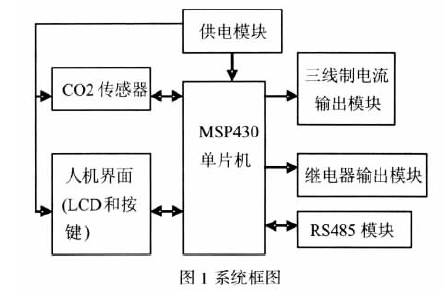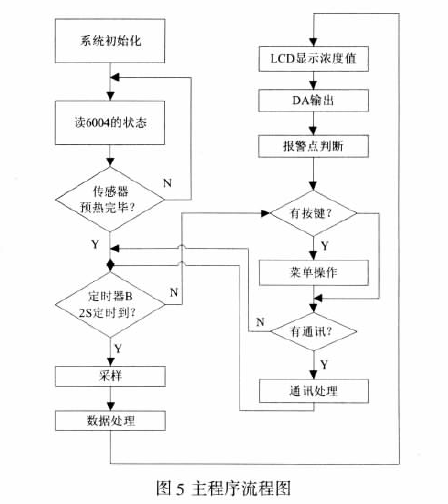Carbon dioxide detectors are of great importance in industry, agriculture, medicine, and environmental protection. The use of single-chip microcomputer for carbon dioxide concentration detection, display, real-time control can improve production efficiency and save energy. In addition, in the industrial field, long-term transmission of signals is often required. If the transmitted signal is a voltage signal, the transmission line will be disturbed by noise, and the distribution resistance of the transmission line will produce a voltage drop. To solve the above problems and avoid the influence of the related noise, consider The current is used to transmit the signal because the current is not sensitive to noise. To this end, this article describes a carbon dioxide detection system using the MSP430F169 monolithic control, and with a three-wire 4 ~ 20mA current output, you can also use the standard Modbus protocol to communicate with the host computer.

1 system hardware design Figure 1 is a block diagram of the system. The single-chip microcomputer reads the signal (density value) sent by the carbon dioxide sensor through the serial communication port, displays it on the LCD after internal processing, and at the same time converts it into the corresponding 4~20mA current output, or sends the CO2 concentration value to the host computer through the RS485 serial port. . At the same time, the single-chip microcomputer compares the sampled signal with the alarm point set by the system and controls the pull-in of the corresponding relay. In addition, you can also use the button or the host computer software to modify the system parameters through the RS485 serial port: Altitude, alarm point, communication address, communication baud rate, ABC logic, password, output current calibration.
1.1 CPU and Peripheral Circuit Interface To maximize the use of microcontroller ports and on-chip peripherals and reduce design costs, the system uses the MSP430F169. The microcontroller has features such as extremely low power consumption, powerful processing capabilities, abundant on-chip peripheral modules, and convenient and efficient development methods. It has two 16-bit timers, a built-in 12-bit AD converter and a dual 12-bit DA converter, two serial communication interfaces, 60KB FLASH, fully satisfied with the needs of the system. The CPU uses an internal 1MHz crystal. The microcontroller controls the operation of the LCD through the SPI mode and recognizes the status of the four buttons via an external interrupt. The P6.2 and P6.3 ports of the microcontroller control the pull-in of the two relays. In addition, the two serial ports of the SCM are used to communicate with the CO2 sensor and the 485 respectively.
1.2 Sensor Circuit This design adopts infrared absorption sensor 6004 produced by Telaire, USA. The sensor uses non-dispersive infrared (NDIR) principle to detect carbon dioxide concentration, consisting of a gold-plated packaged optical system and other strictly selected signal amplification and processing components. The measurement range is 0~5000ppm; measurement accuracy: error of ±40ppm or 3% of reading compared with the factory standard gas at 22°C; response time: less than 2 minutes can reach 90% of the typical step change; signal Change period: Every 2 seconds. The maximum power consumption is 150mA and the average power consumption is 30mA. The 6004 sensor module has the following two output modes: Analog output: 0~4VDC; Digital port: SPI/Microwire or UART (9600bps), which has a corresponding communication protocol. At present, most products on the market are detecting analog output signals and the signal processing is simple. Considering that the digital output is more accurate than the analog output and the noise immunity is good, the design uses a UART interface to read the digital signal output by the sensor. Since the 6004 is incompatible with the level of the MSP430F169, the 6004's serial output (TDX) is voltage-suppressed to the P3.7 (URXD1) port of the MSP430F169. The serial input (RDX) of the 6004 goes through a high-speed optocoupler. The chip HCPL0631 is boosted to the P3.6 (UTXD1) port of the MSP430F169. Specific circuit shown in Figure 2.

1.3 Three-wire current output module The 4~20mA current loop has two types: two-wire and three-wire. The system uses three-wire system. Figure 3 is a VI conversion circuit that provides one 3-wire 4~20mA current output. U4 in the figure uses the TLE2022 op amp, a precision, high-speed, low-power op amp that offers significant improvements in unity-gain bandwidth and ramp rates compared to similar devices. The device maintains high accuracy even when the temperature changes and is used for many years. Here, the TLE2022 is powered by +24V and -5V power supplies. Using a negative power supply allows the op amp to output a relatively wide control voltage to ensure that the op amp can output 0V because some op amps output 0V at the supply timing and cannot output. 0V, always 1 to 2 volts high. And the op amp can also receive negative pressure signal input, especially AC voltage signal. This circuit significantly improves the resistance to load variation while ensuring high accuracy of VI conversion. Analyze the circuit to know: So in order to obtain 4~20mA of output current, the voltage that the one-chip computer DA converts and outputs is controlled in 0.2~1V1.4 RS485 communication module communication module realized long-range data communication between the one-chip computer and upper computer. The system communicates directly with the MAX3485 chip through the USART0 of the microcontroller and communicates with the host computer according to the standard MODBUS protocol. As shown in Figure 4, the MAX3485's serial output (TXD485) is connected to the MSP430F169's P3.4 (UTXD0) port, and the serial input (RXD485) is connected to the MSP430F169's P3.5 (URXD0) port. MSP430F169 P6.4 port and KCOM, used to enable the MAX3485 serial input and output.

3 software design The system program is written in C language, Figure 5 is the main program flow chart.
3.1 Communication Between MCU and 6004 Telaire specific communication protocol is used between the MCU and 6004. The main operation between them is to read the 6004 state, read the CO2 concentration value, set the altitude, and set the ABC logic. After the system is powered on, read 6004 until 6004 warm-up is completed before reading the sensor's density. Read every 2S.

3.2 Communication between MCU and 485 Communication between MCU and 485 adopts standard MODBUS protocol, mainly reading CO2 concentration, reading alarm status, reading relay status, and modifying system parameters. Modbus is divided into two transmission modes: ASCII and RTU. The RTU transmission mode is selected here. The main advantage of this method is that more data can be transmitted than ASCII at the same baud rate.
4 Conclusion The system is accurate, has a good man-machine interface, operation intelligence, reliable system operation, can be widely used in commercial building control, air conditioning management, intelligent residential, shopping malls, hotels, stadiums, cinemas, airports, Internet cafes, Greenhouse agriculture greenhouses and so on. The author of this article innovates: The infrared absorption type sensor is selected, and its digital output signal is read with high accuracy and good anti-interference. A novel three-wire current output circuit is used. This circuit has high accuracy and strong resistance to load changes. Use standard MODBUS protocol to communicate with the host computer.
Related Products: Wind Anemometer Photosynthetically Active Radiation Recorder Nitrogen Determination Instrument
Thermowave Heat Exchanger Plates
Thermowave heat exchanger plates are made from high-quality materials, such as stainless steel or titanium, to ensure durability and corrosion resistance. The plates are designed with various patterns and configurations to optimize heat transfer efficiency and minimize pressure drop.
Thermowave heat exchanger plates are known for their high thermal efficiency, compact design, and easy maintenance. They are designed to provide reliable and efficient heat transfer, while also being easy to clean and service.
Various models of Baode heat exchanger plates have deep ripples, shallow ripples, large Angle, small Angle, etc., to fully ensure that the needs of different users can be met, special conditions can be specially designed and manufactured according to user needs.
As the world's leading plate heat exchanger plate manufacturer and seller, Baode has a wide variety of domestic plate heat exchanger plates, more models! It can provide all common types of plate heat exchanger plates from well-known brands at home and abroad (including: AlfaLaval /GEA, TRANTER, SONDEX/HISAKA/APV/Thermowave /Schmidt/FUNKE/VICARB/LHE, etc.).
Thermowave Heat Exchanger Plates, Thermowave Plate Heat Exchanger Plates, Heat Exchanger Plates for Thermowave
Jiangsu Baode Heat-Exchanger Equipment Co.,LTD , https://www.baodehex.com